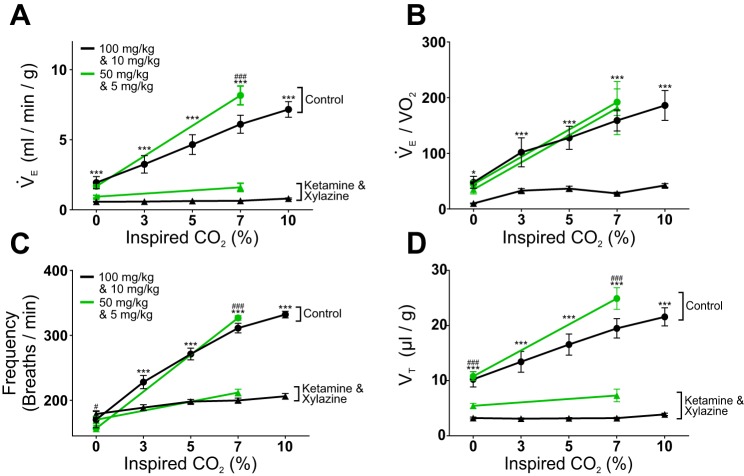Fig. 2.
Ketamine-xylazine anesthesia markedly reduced the hypercapnic ventilatory response (HCVR) in vivo. A: ketamine (100 mg/kg) and xylazine (10 mg/kg) caused a reduction in breathing at baseline (0% CO2; P < 0.001) and in the slope of V̇e as the percentage of inspired CO2 rose in C57Bl/6 mice (black lines; F4,56 = 45.60, P < 0.001, n = 15). A subtherapeutic dose of ketamine (50 mg/kg) and xylazine (5 mg/kg) also markedly decreased the slope of V̇e as CO2 increased to 7% (green lines; F1,13 = 159.3, P < 0.001, n = 14). B: ketamine (100 mg/kg) and xylazine (10 mg/kg) anesthesia caused a reduction in V̇e/V̇o2 in 0% CO2 and in the slope of V̇e/V̇o2 as CO2 increased (black lines; F4,56 = 9.941, P < 0.001, n = 15). The subtherapeutic dose of ketamine (50 mg/kg) and xylazine (5 mg/kg) did not alter the V̇e/V̇o2 (green lines; F1,13 = 6.967 × 10−4, P = 0.9793, n = 14). C: the FR component of the HCVR was equally affected by both the therapeutic and subtherapeutic doses of ketamine and xylazine. Ketamine (100 mg/kg) and xylazine (10 mg/kg) showed a reduction in the increase in FR as the CO2 level was raised (black lines; F4,56 = 80.04, P < 0.001, n = 15). The subtherapeutic dose of ketamine and xylazine (50 and 5 mg/kg) also caused a marked reduction in FR in 7% CO2 (green lines; F1,13 = 359.30, P < 0.001, n = 14). D: VT did not increase in response to higher CO2 levels with ketamine and xylazine administration. Ketamine (100 mg/kg) and xylazine (10 mg/kg) reduced the VT in 0% CO2 (P < 0.001) and slope of the increase in VT in response to CO2 (black lines; F4,56 = 29.38, P < 0.001, n = 14). Similarly, the subtherapeutic dose (50 and 5 mg/kg; green lines) reduced both the baseline VT (P < 0.001) and the increase in VT in response to CO2 (F1,13 = 170.30, P < 0.001, n = 14). *P < 0.05, ***P < 0.001 for therapeutic dose (100 and 10 mg/kg; black lines); #P < 0.05, ###P < 0.001 for subtherapeutic dose (50 and 5 mg/kg; green lines).

